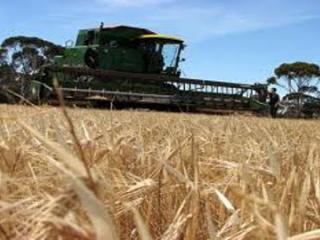The harvesting operation is crucial in determining the grain yield and quality of barley. For malting barley, unless the grain has a germination percentage above 98% it is not suitable for sale to maltsters. Therefore, how you handle your barley grain at harvest is critical as viability of the grain must be maintained. Factors such as skinning the grain due to over threshing, storing wet due to harvesting high grain moisture without aeration or drying to temperatures above 43°C all contribute to the reduction in the quality of barley for use in the malting and brewing industry and in the feed industry. Because of this, the potential for a premium price and the possibility of head loss or weather damage means malting barley should be harvested as soon as the crop is at a moisture content that is suitable for storage.
The method of harvesting that is chosen will have a large bearing on grain moisture content, likely yield losses and risk of damage from weathering.
Direct heading of dry barley
The simplest and most common harvesting method for barley is to wait until the grain has ripened and dried to a moisture content of less than 12% so that it can be delivered directly to the receival point. Once the crop is ripe, harvest as soon as possible to reduce the potential losses from wind damage or weathering. It is important when direct heading barley to:
- prevent the skinning and cracking of grain by correctly setting up the harvester
- avoid contamination by ensuring the harvesting and grain movement equipment is clean
- reduce grain losses and damage by monitoring the sample throughout the day and adjust thresher speeds and concave to suit conditions as they change
- use correct screens to remove small grain, weed seed and contaminants.
While the direct heading of dry grain is the cheapest method of harvesting, the danger is that there may be long periods of high relative humidity in which the harvesting of 'dry' grain is not possible. This may cause considerable delays to the harvesting operation and increase the risk of head loss or grain being discoloured by early summer rains.
It is important to note that once the moisture in the grain falls below 10%, the grain becomes susceptible to skinning due to over threshing. Skinned barley takes up moisture faster during the steeping phase of the malting process than grain with its husk intact. This can lead to death of the grain because it cannot regulate water uptake or excessive root and shoot growth. For the brewer this leads to reduced alcohol yield. Skinned grain is very noticeable to grain buyers in the dried malt sample as it during kilning it turns pink. Correct setup of the header is very important to ensure that over threshing of the barley grain does not occur.
High moisture harvest and aeration or grain drying
To reduce harvesting delays the grain can be direct harvested at a moisture content above 12% and then placed under aeration to maintain quality or passed through a grain dryer to reduce its moisture content to a level that can be safely stored.
Malting barley can be harvested once the grain has reached physiological maturity (dough stage) and when the moisture content is no more than 18%. Harvesting at a moisture level above this is limited by the ability of most harvesters to successfully thresh grain from the head.
Considering aeration or drying costs and practicalities, the best moisture content at harvest for malting barley is around 14-15%. If moist grain cannot be effectively handled, harvest at a moisture content of less than 12.5%.



